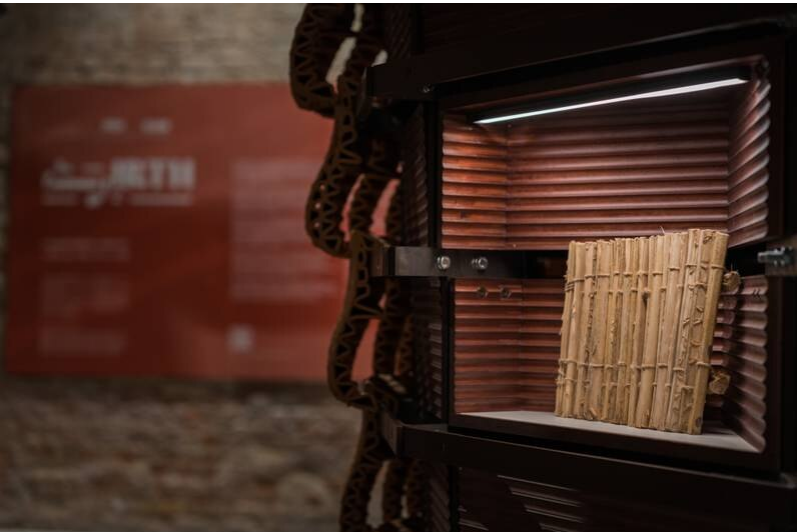This year’s Venice Architecture Biennale has as its theme “The Laboratory of the Future.” The laboratory part of the title suggests experimentation and radical rethinking.
 The National Pavilion of Saudi Arabia shows a series of more traditional yet still alluring spaces with arches on either side of a rectangular central room that feels almost cave-like and prehistoric. Inside the dimly lit central space is just one object – a hollow 3D-printed clay column from which light is projected on to the floor, walls and ceiling. The patterns are inspired by undulating desert dunes and the vernacular architecture of Asir, a region in the south-west of the country that consists of coastal plains and high mountains.
The National Pavilion of Saudi Arabia shows a series of more traditional yet still alluring spaces with arches on either side of a rectangular central room that feels almost cave-like and prehistoric. Inside the dimly lit central space is just one object – a hollow 3D-printed clay column from which light is projected on to the floor, walls and ceiling. The patterns are inspired by undulating desert dunes and the vernacular architecture of Asir, a region in the south-west of the country that consists of coastal plains and high mountains.
This object will be relocated to the bottom of the Red Sea eventually, where they will create new habitats for marine life and leave a legacy for future generations.
It is in this long cavernous central space that one can also smell a fragrance created specifically for the pavilion. “It was designed to capture elements of the culture,” explains the assistant curator. “We have frankincense, which was a core element of our trade routes, we have myrrh and we also have lavender. It’s our way of introducing Saudi Arabia to the world. When we talk about architecture we always forget the unseen and focus on the visual.”
The curators of the Saudi pavilion are keen to emphasize that the pavilion is “a collaborative effort … that seeks to finds common ground in its desire to improve the human condition and answer the challenges confronting our world.” In practice, what this means is that aside from being a series of beautiful, tactile and scented spaces, the pavilion also functions as a sort of incubator where you can find out more about the latest material experimentation in Saudi Arabia displayed in open vitrines dotted around the arches.
 On display is some incredibly lifelike 3D printed coral. Coral reefs are created by tiny marine animals that secrete a calcareous skeleton and are some of the most complex and vital three-dimensional structures on earth, providing vital coastal protection and homes to marine life. As coral reefs grow very slowly and they are increasingly under stress from ocean acidification, these 3D printed models are being used to restore and replenish coastal marine landscapes in the Red Sea.
On display is some incredibly lifelike 3D printed coral. Coral reefs are created by tiny marine animals that secrete a calcareous skeleton and are some of the most complex and vital three-dimensional structures on earth, providing vital coastal protection and homes to marine life. As coral reefs grow very slowly and they are increasingly under stress from ocean acidification, these 3D printed models are being used to restore and replenish coastal marine landscapes in the Red Sea.
Fossilised coral limestone blocks up to 250,000 years old were used in Al Balad for their porous properties and abilities to insulate against the salty air. The blocks were bound with a mortar made of lime and clay from the seabed.
 We also see compressed building blocks made of soil and crushed stone – a sort of local rammed earth.
We also see compressed building blocks made of soil and crushed stone – a sort of local rammed earth.
 Woven palm panels can be used to make roofs or shading structures, as well as walls and screens. Saudi Arabia has more than 31 million palm trees.
Woven palm panels can be used to make roofs or shading structures, as well as walls and screens. Saudi Arabia has more than 31 million palm trees.
Roth Architecture experiments with salt brine by combining various forms of salt with calcium carbonate, borax and recycled polypropylene. As a by-product of the desalination processes, salt is plentiful in the region and not typically used in construction. Potential future applications that are being developed include wall finishes, tiles, screens and lamps.
When viewed as a whole, the pavilion can be seen as a bridge between the past and the future, as well as a workshop for the creation of new materials.
You can read the original article at www.thenationalnews.com

